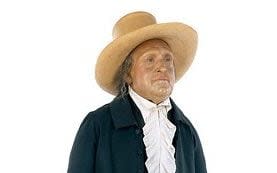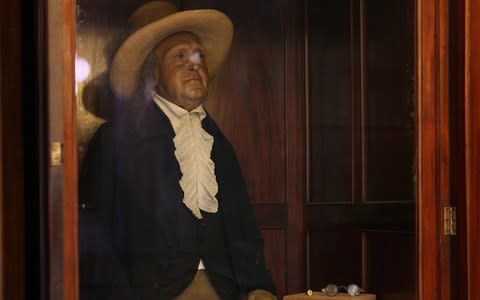Experts hunt for missing mourning rings of eccentric philosopher Jeremy Bentham

It might be considered the ultimate memento mori to have your body wired and stuffed so you can be wheeled out at parties after death.
But eccentric philosopher Jeremy Bentham went a step further in ensuring that his friends did not forget him by bequeathing rings containing his bust in silhouette and strands of hair.
The social reformer who died in 1832, began making plans for his legacy from the age of 21, insisting his body be preserved as an ‘auto-icon’ and leaving a list of 26 individuals who were to receive a special mourning ring.
University College London (UCL) where Bentham’s body remains on display, has managed to track down six of the rings, but is hunting for the missing 20.
The silhouette portraits of Bentham were created by the artist John Field, who at the time was working by appointment to William IV and Queen Adelaide.
“The mourning rings were probably commissioned by Bentham in 1822, when he had his silhouette painted by Field,” said Dr Tim Causer, UCL Bentham Project.
“We also know that on 2 November 1822 Bentham’s secretary took some of his hair to Field and his partner John Miers for the rings,” said Dr Tim Causer, UCL Bentham Project.

Bentham was a leading philosopher and social thinker of the 18th and early 19th century, establishing himself as a leading theorist in social and economic reform.
He was pivotal in the establishment of Britain’s first police force, the Thames River Police in 1800 which was the precedent for Robert Peel’s reforms 30 years later. He also argued for the rights of women, for homosexuality to be legalised.
A notable eccentric, Bentham called his walking stick Dapple, his teapot Dickey, and kept an elderly cat named The Reverend Sir John Langbourne.
But it was his loathing of the church which he described as ‘nonsense on stilts’ which led him to donating his organs to medical science and insisting his body be placed on public display.

Subhadra Das, Curator at UCL Culture, said: “Bentham revolutionised our idea of what death is.
“When Bentham donated his body for the advancement of science it was considered a social taboo, but his ideas framed the Anatomy Act 1832 that allowed medical practitioners and students to dissect donated bodies.
“The memorial rings also help to highlight how attitudes to death and memory have changed over time. The rings and the lock of hair might seem morbid to some today, but it was fairly common practice at the time.
“Our modern, western views of death come from the early 20th Century when World War I made grief a luxury and the psychological theories of Sigmund Freud encouraged its repression. I think the Victorians would find our attitude to death rather cold.”
Of the rings discovered by UCL, three are engraved with the names of their owners publisher and bookseller William Tait (1793–1814), the Belgian politician Sylvain van de Weyer (1802–72), and the other great utilitarian philosopher John Stuart Mill (1806–73).
Mill’s ring was discovered in a jewellery shop in New Orleans, suggesting the remaining rings could be spread throughout the world.
UCL also has an unidentified ring and two others are known to be in the possession of the descendants of William Stockwell, one of Bentham’s servants, while a ring bequeathed to the French economist, Jean-Baptiste Say was recently sold at auction by Christie’s.
However, the whereabouts of the remaining twenty rings remain unknown and they are hoping the descendants of the original owners may be able to help. One ring was seen painted on the finger of José Cecilio del Valle (1780–1834),the Guatemalan philosopher and politician. “We can safely assume that José del Valle received one, as he is featured wearing it in a portrait,” added Dr Causer.
“Interestingly, on the bookshelf of that portrait is one of Bentham’s works as well as a Spanish translation of Say’s Traité d’économie politique. It’s a neat, tangible link between Bentham, Say, and del Valle.”
Anyone who knows the whereabouts of the rings should contact UCL.
The 26 individuals whom Bentham said in his will should receive a ring:
Dr Neil Arnott (1788–1874), Scottish physician and inventor. (Inventor of the Arnott waterbed, and asmokeless fire grate)
Sarah Austin (1793–1867), editor, linguist, and translator, whose husband, John, was the first professor of jurisprudence at the University of London (later UCL)
Henry Bickersteth (1783–1851), first Baron Langdale, law reformer and Master of the Rolls 1836-51
Felix Bodin (1795–1837), French historian and politician
John Bowring (1792–1872), editor, literary translator, and colonial administrator.
Samuel Cartwright (1789–1864), Dentist in Ordinary to George IV, first president of the Odontological Society. (At some point Cartwright had offered Bentham free dental care)
Edwin Chadwick (1800–90), English social reformer, who led the reform of the Poor Law, and of public sanitation. Disciple of Bentham. His papers are in Special Collections
Mary Louise de Chesnel (1797–1865), Bentham’s eldest niece, daughter of Maria-Sophia Bentham and Samuel Bentham (JB’s younger brother).
Richard Doane (1805–48), Bentham’s amanuensis
Marie-Joseph Paul Yves Roch Gilber du Motier, Marquis de Lafayette (1757–1834), aristocrat and military commander
Albany Fonblanque (1793–1872), journalist
James Harfield (d. 1851), Bentham’s secretary
John Stuart Mill (1806–73), philosopher and civil servant
General William Miller (1795–1861), soldier and diplomat. Fought in the Napoleonic Wars, and later known as Guillermo Miller in Latin America for his service in the Peruvian Legion.
Joseph Parkes (1796–1865), solicitor and legal reformer
Francis Place (1771–1851), prominent Philosophical Radical and social reformer
Jean-Baptiste Say (1767–1832), economist, recently sold at auction by Christie’s.
Thomas Southwood Smith (1788–1861), physician and sanitary reformer. Disciple of Bentham, and oversaw the creation of Bentham’s auto-icon.
William Stockwell, servant boy to Bentham, in the possession of a descendent
William Tait, publisher and bookseller (1793–1864). Published the eleven-volume 1838-43 edition of Bentham’s works superintended by John Bowring.
Thomas Perronet Thompson (1783–1869), politician , Governor of Sierra Leone 1808-10
John Tyrrell, barrister
José Cecilio del Valle (1780–1834), Guatemalan philosopher and politician
Jean-Sylvain de Weyer (1802–74), Belgian politician and de-facto Belgian ambassador to the United Kingdom
Mary Watson (presumably another of Bentham’s servants)
George Wheatley, journalist and author of A Visit (in 1831)

 Yahoo News
Yahoo News 